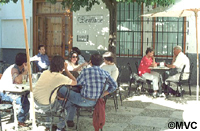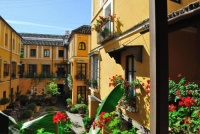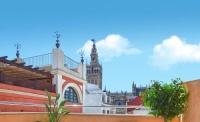Barrio Santa Cruz, district (neighbourhood) of Seville city

Outdoor cafes in Santa Cruz
This is the first barrio (area or neighbourhood) tourists head for, and with good reason. It is the most picturesque and delightful part of the city, with narrow winding cobbled streets and whitewashed houses, where you can sit outside a bar, enjoy some tapas and watch the world go by, or wander through centuries-old gardens and relax on beautiful tiled benches. The area is bordered by Calles Mateas Gago, Santa Maria La Blanca/San José, the Jardines de Murillo and the Alcázar . It was formerly the Jewish quarter; some of the churches were originally synagogues. The covered passageway heading off the Patio de Banderas (part of the Alcázar) called the Judería is worth visiting; enter the Patio from here and you'll get an unforgettable view of the cathedral.
Wandering round the small squares lined with orange trees (especially Plazas Doña Elvira and Santa Cruz), getting lost in the maze of improbably narrow alleys, where the ancient houses lean so far towards each other that they almost seem to touch, and admiring the leafy patios of private mansions through their iron gates, will be one of the best experiences of your visit to Seville. It is incredibly picturesque and full of history and stories, with many old palaces, churches and hidden passageways. There are, predictably, many tourist shops selling typical tourist fare such as inferior quality azulejos (tiles), flamenco dress-style aprons and T-shirts with naff slogans. But there are also some individual, interesting artesan stores - see shopping page.
Don't miss Callejon del Agua (Water Alley), a narrow, shaded lane which follows the Alcázar garden walls and is named after a watercourse which ran along the top of the wall. At the end of it is Plaza Alfaro, inspiration for the balcony scene in Romeo and Juliet. Next to this is the delightful Plaza Santa Cruz, with rose beds bordered by hedges and an intricate 17th-century wrought iron cross in the centre, La Cerrajería, which commemorates the church destroyed by the French in 1810. Murillo, one of Spain's most important painters, was born in Plaza Santa Cruz and you can visit his house in Calle Santa Teresa where there's a small museum. In Plaza Refinadores, a small square between Plaza Santa Cruz and Calle Santa María La Blanca, there's a statue of Don Juan Tenorio, one of Seville's most famous literary characters.
The main sights in terms of buildings are the Cathedral and Giralda, formerly a minaret (mosque's tower), the Alcázar (royal fortified palace) and the baroque Hospital of the Venerables (originally a home for retired priests) whose chapel houses a fine collection of paintings as well as murals by Valdés Leal; the hospital also holds temporary exhibitions. The Archivo de Indias, which houses all maps and documents about Spain's conquest of the New World, is open to the public and stages frequent exhibitions, as well as offering an unparalleled historical resource.
For eating out, Mateas Gago is hard to beat, in terms of quality and selection, with wall-to-wall tapas joints from tiny hole-in-the-wall spit-and-sawdust joints to smart restaurants.
One interesting fact about this area is that much of it was nearly destroyed in the rash of development before the 1929 Expo; plans for a wide, modern avenue between Plaza de los Reyes, in front of the Giralda, and the Jardines del Murillo were shelved thanks to the intervention of various royalty including King Alfonso XIII.




